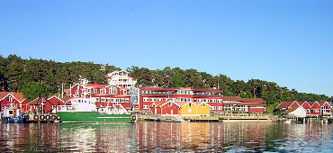|
Tjärnö Marin Biological [Akademiska Hus] Via an
intranet-based report program laboratory scientists and students can get
instantaneous and historical readings from the AP installed weather
station at Tjärnö for example temperature, humidity, wind speed, air
pressure, rainfall and other important readings.
AP provides efficient systems and instruments to identify and evaluate
weather data.
The picture shows an aerodynamic rain gauge, WRG 100, which is designed
to reduce the resistance and turbulence and is designed to have a small
surface area against the wind and can be placed in exposed locations.
The rain is measured by the well-tested "Tipping bucket" method.
The rain is collected in the hopper and sent to one of the two
reservoirs located on each side of a short balancing arm.
The balancing arm tilts over when the first reservoir is full, empties
the reservoir and places the second reservoir under the hopper.
This is repeated again and again until the rain stops falling and each
discharge represents a specific volume of rainwater.
At each discharge the mobile arm forces a magnet to pass over a reed
relay with the result that a contact closes for a few milliseconds.
The pulses created by rainfall can be calculated during a preset time
interval and carefully establishes the amount of the rainfall. |
 |
|
Rikshospitalet, Oslo installs
weather station from AP
The DUC is connected to the wind speed and
direction along with moisture and temperature regulation.
The DUC controls, over the network, awnings, shutters and blinds fully
automatically.
At sunshine, for example, the awnings are rolled out and at dusk they
rolled up.
The Weather Station WSD is a combination of wind
speed and wind direction sensors and is made of a shiny anodized
aluminum alloy.
The wind speed component consists of a light weight cone made of ABS for
rapid response, mounted on a double counterbalanced shaft made of
stainless steel.
It uses a Bremag 10 magnet which operates a moist mercury reed relay,
which gives a smooth pulse from the rotor at each revolution.
The wind component consists of the dynamically balanced weather vane,
which operates a triple counterbalanced shaft and a micro pivoted 357
degree potentiometer with a dead zone at 3 degrees north.
With the above construction, most modern data logs/DUC:s or PLC can be
connected to the sensors with or without interfaces. |
 |